You know you need a Chief Information Security Officer (CISO). So what do you do next? There is a difference between finding a CISO and the right CISO for your organization. We’re sharing some things to help you make a CISO decision that will set your organization up for success.
Are you ready for a CISO?
Yes, there is a difference between needing a CISO and being ready for one. However, adding an executive-level presence represents a significant organizational change that, when considered in advance, can significantly impact the success of your information security program.
Determining where the CISO belongs in your organization is important. Bringing a CISO on board means creating supporting roles for their team. You don’t want a security professional guiding your strategy without the ability to execute it. Is the organization ready to add these supporting roles?
What type of person is right for your organization?
When adding a CISO, you want to consider the right person for your organization. Often, that goes beyond credentials; you want someone with experiences that can be applied to your CISO position.
Another consideration here is your potential candidiate’s demeanor on risk. Does your organization view security as black and white? Or do you have some gray areas? Again, you want a professional that aligns with your answers.
You should also ask yourself what kind of partner you want. For example, CISOs can be business drivers or security practitioners. Does one of those feel better for your organization and where you want to go?
Do you have enough for them to do?
Even though you need a full-time CISO, it’s worth asking if you have enough for them to do. CISO roles are more in-demand and there is a shortfall of qualified professionals. In a supply and demand economy, you will have to offer an attractive compensation package to attract a candidate, not to mention the time and effort it takes to move through the recruiting process.
To make that type of commitment, you should think about the long-term responsibilities of your (potential) CISO. Do you need to bring them in as a reaction to a regulatory issue, or is the emphasis on information security part of your organization’s strategic goals?
For many organizations, the full-time role of CISO isn’t a necessity, even though there is a need for strategic guidance in information security.
As organizations face the increased need for a CISO, they also compete for a limited number of qualified professionals. Or realize that they need more work to balance the investment of this executive presence. This is where a fractional or virtual chief information security officer (vCISO) comes into play.
A vCISO can provide strategic support, often comes with their own team to execute that strategy, and has the broad experience to jump into a new organization with limited onboarding time, which is ideal for organizations needing information security guidance but not as a stand-alone role.
Whether a virtual or in-house CISO is right for your organization, ensuring you are ready for them to integrate into your leadership team and that they are the right fit for your organization is critical. Let’s chat if you’re curious about Digital Silence’s approach to the vCISO role.
